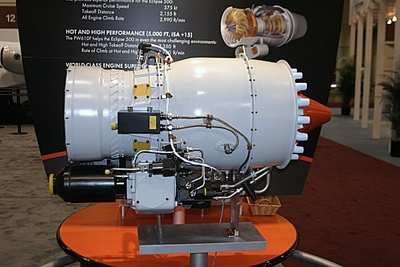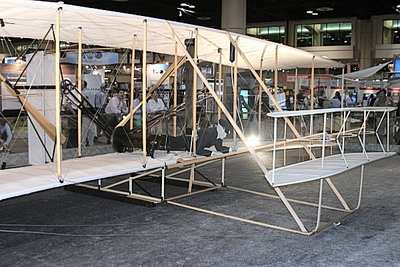Eclipse Aviation Program Celebrates 100th Anniversary of Wright
Brothers' First Flight As Part of EAA's Countdown to Kitty
Hawk
The jet engine is
it. Eclipse Aviation today announced the jet engine is the
people's choice in its Greatest Aviation Innovations voting as part
of Experimental Aircraft Association's (EAA) Countdown to Kitty
Hawk. Since April 2003, more than 16,051 people have voted either
online or in person for their top pick of the 10 greatest aviation
innovations.
Eclipse Aviation made the announcement at the National Business
Aviation Association's (NBAA) 56th Annual Meeting & Convention
in Orlando as part of its involvement in EAA's Countdown to Kitty
Hawk, a yearlong celebration of the centennial of powered flight.
The Albuquerque, N.M., developer of the Eclipse 500 jet is a
sponsor of EAA's Countdown to Kitty Hawk presented by Ford Motor
Company. Microsoft Flight Simulator and Northrop Grumman are also
sponsors. The Countdown to Kitty Hawk touring pavilion, which
includes interactive aviation exhibits and the world's most
authentic 1903 Wright Flyer reproduction, was brought to NBAA this
week by Eclipse and its sponsoring partners, including NBAA, Parker
Aerospace, Mecaer, Mach 2 Management, Avidyne, Aerazur, EDS,
Seamech and QualPro Strategies.
Through its presentation of the Greatest Aviation Innovations of
the First 100 Years, Eclipse highlighted each of the 10 innovations
with interactive displays in the Countdown to Kitty Hawk pavilion.
Vote tallies and descriptions for each of these innovations
include:
Eclipse Aviation's Greatest Aviation Innovations (% Votes)
- 1903 Wright Flyer -
Pointed the way for all successful aircraft that followed it.
(37.1)
- Douglas DC-3/Boeing 247 - The first modern airliners.
(3.4)
- Jet Engine - The biggest advance in propulsion. (37.4)
- Sikorsky VS-300 Helicopter - Made vertical flight a reality.
(2.2)
- Piper Cub - The plane that introduced thousands of people to
the joy of flying and made "Cub" a synonym for small
plane.(7.5)
- Boeing 747 - Proved those wrong who doubted there would be
enough passengers to make the "big bird" profitable. (4.6)
- Controllable Pitch Propeller - Unlocked the key to getting full
performance potential out of any engine.(1.6)
- Air Traffic Control (ATC) Technology - Introduced a unified
system of air traffic control. (3.7)
- Learjet - Revolutionized business aviation and became
synonymous with "business jet." (1.4)
- De Havilland Comet & Boeing Dash 80 - Set the performance
benchmark for the jet airliners that followed. (1.1)
"Eclipse is committed to revolutionizing the future of air
transportation in the next century, so it is fitting that we
sponsor the Greatest Aviation Innovations program which highlights
and honors mankind's greatest aviation innovations for the first
century of flight," said Vern Raburn, president and CEO of Eclipse
Aviation. "Through our program, we are celebrating 100 years of
aviation history and the spirit of innovation that was first
exemplified by two bicycle makers from Ohio."

"There can be no doubt that the introduction of the jet engine
was one of the great turning points in the history of flight," said
Dr. Tom Crouch, senior curator of aeronautics with the
Smithsonian's National Air and Space Museum, and one of the judges
in the competition that identified the top 10 civil aviation
innovations for voter consideration. "Independently invented by Dr.
Hans von Ohain in Germany and Sir Frank Whittle in Great Britain,
turbojet propulsion inaugurated the era of mass commercial air
transportation."
Earlier this year, judges for the Greatest Aviation Innovations
program selected the 10 aviation milestones that have most
significantly benefited travelers by decreasing travel time,
increasing comfort, reducing cost and improving air safety. In
addition to Crouch, the other panelists included: Richard Collins
of FLYING magazine; Scott Spangler of EAA AirVenture Museum; Jack
Olcott of the National Business Aviation Association; Michael Fopp
of the Royal Air Force Museum; and Sir Peter Masefield, aviation
historian.
The Countdown to Kitty Hawk pavilion is located in Booth #4543.
The NBAA Convention is being held at the Orange County Convention
Center in Orlando.

A Little History...
By the mid-1940s, aircraft were sporting huge piston engines
with up to 28 cylinders and 3,500 horsepower. Larger engines were
on the drawing boards, but their complexity was daunting and their
days numbered. British designer Frank Whittle bench-tested the
first practical jet engine in England in 1937, but design problems
kept it in the lab. The first operational jet airplane appeared in
early 1944 - Germany's Messerschmitt 262 Schwalbe (Swallow). At 540
mph, the Me 262 was nearly 75 mph faster than its fastest
piston-engined opponent. Introduced too late to change the course
of World War II, the Me 262 still led the world into the jet
age.
 ANN's Daily Aero-Linx (05.06.25)
ANN's Daily Aero-Linx (05.06.25) ANN's Daily Aero-Term (05.06.25): Ultrahigh Frequency (UHF)
ANN's Daily Aero-Term (05.06.25): Ultrahigh Frequency (UHF) ANN FAQ: Q&A 101
ANN FAQ: Q&A 101 Classic Aero-TV: Virtual Reality Painting--PPG Leverages Technology for Training
Classic Aero-TV: Virtual Reality Painting--PPG Leverages Technology for Training Airborne 05.02.25: Joby Crewed Milestone, Diamond Club, Canadian Pilot Insurance
Airborne 05.02.25: Joby Crewed Milestone, Diamond Club, Canadian Pilot Insurance




